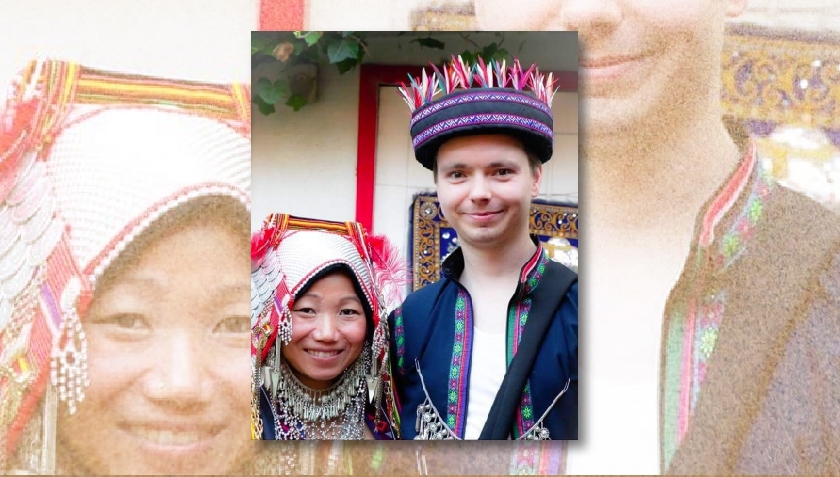Constructing the Self-image of Akha women in Cross-Cultural Marriage
Keywords:
Akha, self, cultural capital, flexible citizen, cross cultural marriageAbstract
The purpose of this article is to present the self-image of Akha women married to foreigners. This study used narrative analysis and in-depth interviews as the research methodology. The study indicated that two important factors contributing to the self–image of women are their ethnic identity or cultural roots, and the route of life. Ethnic identity is a form of cumulative cultural capital and is used when crossing borders. As the route of life forms a new identity that breaks out from the pressures of ethnic identity, there are some embedded insights. Cross-cultural self is a hybrid identity, flexible and negotiable as an agency which is not attached to the ethnic identity discourse. It is a flexible citizen or globalized citizen who can choose to embrace a diversity of identities. One is the self that originates from ethnic capital that is rooted in women’s relationships with their former family, envisioning the source of life. The other is the modern self that emanates from the route of life in a foreign country that gives women the liberty which they could not have in the Akha world.
References
Appadurai, Arjun, 2008. Modernity at Large: Cultural Dimensions of Globalization. Minnesota: The University of Minnesota Press.
Bourdieu, Pierre, 1997. “The form of Capital” In Halsey, A.H., H. Lauder, P. Brown and A.S. Wells. (eds.), Education: Culture, Economy, Society. Oxford: Oxford University Press.
Cohen, Erik, 1982. Thai Girls and Farang men: The Edge of Ambiguity. Annals of Tourism Research. 9 Issue 3: 403-428.
Constable, Nicole (ed.), (2005). Cross-Border Marriages: Gender and Mobility in Transnational Asia. Philadelphia: University of Pennsylvania Press.
Denzin, Norman K., 1992. Symbolic Interactionism and Cultural Studies. USA.: Blackwell.
Elliott, Anthony, 2014. Concepts of the Self. Third Edition. UK.: Polity Press.
Goffman, Erving, 1972. The Presentation of Self in Everyday Life. Australia: Penguin Books.
Jeffrey, Leslie Ann, 2002. Sex and Border: Gender, National Identity, and Prostitution Policy in Thailand. Chiangmai: Silkworm Books.
Ong, Aihwa, 1999. Flexible Citizenship: The Cultural Logics of Transnationality. London: Duke University Press.
Panitee Suksomboon, 2009. Thai Migrant Women in the Netherlands: Cross-Cultural Marriages and Families. The Netherlands: Ponsen & Looijen bv, Ede,. (ter verkrijging van de graad van Doctor aan de Universiteit Leiden, op gezag van Rector Magnificus Prof. mr. P.F. van der Heijden, volgens besluit van het College voor Promoties te verdedigen op donderdag 11 Juni 2009 klokke 11.15 uur.
Patcharin Lapanun, 2010. “Transnatoinal Marriages of Rural Isan Women and the Local Influences.”, RCSD International Conference “Revisiting Agrarian Transfomations in Southeast Asia: Empirical, Theoretical and Applied Perspectives” (pp. 1-25). Chiang Mai, 13-15 May 2010.
Prus, Robert, 1996. Symbolic Interaction and Ethnographic Research: Intersubjectivity and the Study of Lives Experience. New York: State University of New York Press.
Ratana Boonmathya, 2005. “Women, Transnational Migration, and Cross-Cultural Marriages: Experiences of ‘Phanrayaa-farang’ from Rural Northeastern Thailand.” Association for Asian Meeting (ASS) Meeting in Chicago, 31 March-3 Apirl 2005.
Robertson, Roland, 1992. Globalization: Social Theory and Global Culture. London: SAGE Publications Ltd.
Sirijit Sunanta, 2014. Thailand and the Global Intimate: Transnational Marriages, Health Tourism and Retirement Migration. Göttingen: Max Planck Institute for the Study of Religious and Ethnic Diversity.
Suriya Smutkupt and Pattana Kitiarsa, 2014. “Cross-Border Hypergamy and Gendered Agency: Farang Husbands and Isan Wives on the Global Culture State.” In John A. Marston (ed.), Ethnicity, Borders, and the Grassroots Interface with the State. (pp. 215-244). Chiangmai: Silworm Books.

Downloads
Published
Issue
Section
License
บทความนี้เป็นผลงานของข้าพเจ้าแต่เพียงผู้เดียว และ/หรือเป็นผลงานของข้าพเจ้าและผู้ร่วมงาน ตามชื่อที่ระบุในบทความจริง และเป็นผลงานที่มิได้ถูกนำเสนอหรือตีพิมพ์ที่ใดมาก่อน




